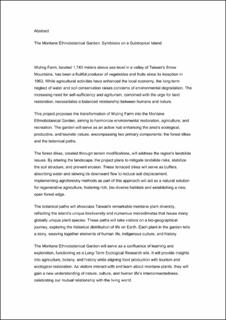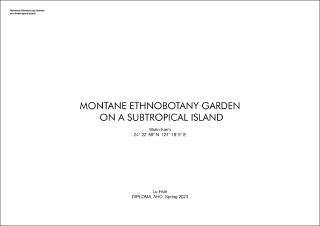| dc.description | Wuling Farm, located 1,740 meters above sea level in a valley of Taiwan’s Snow Mountains, has been a fruitful producer of vegetables and fruits since its inception in 1963. Recognized as a nature reserve. The farm harbors unique ecological resources that contribute to its immense biodiversity. While agricultural activities have enhanced the local economy, the long-term neglect of water and soil conservation raises concerns of environmental degradation. The increasing need for self-sufficiency and agritourism, combined with the urge for land restoration, necessitates a balanced relationship between humans and nature.
This project proposes the transformation of Wuling Farm into the Montane Ethnobotanical Garden, aiming to harmonize environmental restoration, agriculture, and recreation. The garden will serve as an active hub enhancing the area’s ecological, productive, and touristic values, encompassing two primary components: regenerative agriculture and the botanical paths.
The First part is regenerative agriculture which addresses landslide issues while integrating environmental restoration with fruit production. The forest dikes, created through terrain modifications with water-efficient plants will stabilize soil, prevents erosion, and creates natural buffers for environmental protection. Implementing agroforestry methods as part of this approach will act as a natural solution for regenerative agriculture, fostering rich, bio-diverse habitats and establishing a new, open forest edge.
The second part is the Botanical Garden, a mountainside pathway leading to Taiwan’s second-highest peak, Snow Mountain. The garden celebrate endemic and native species found in snow mountain area, sybolizing the island’s rich natural heritage. It is a space designed for interaction and education, it aims to teach individuals how to observe and connect with various forms of life and appreciate indigenous culture.
Arranged by growing conditions, the garden encompasses five main areas: Cultivation Fields, Gallery of Milieu, Natural Classroom, Native Plant Garden, and Ethnic Plant Garden. These sectors represent the environmental characteristics of the surroundings, each showcasing different aspects and attractions of the area which form a continuous journey . In the end of the path, it will connects seamlessly to the primary mountain landscape.
In conclusion,The Montane Ethnobotanical Garden will serve as a confluence of learning and exploration, functioning as a Long-Term Ecological Research site. It will provide insights into agriculture, botany, and history while aligning food production with tourism and ecological restoration.
As visitors interact with and learn about montane plants, they will gain a new understanding of nature, culture, and human life’s interconnectedness, celebrating our reciprocal relationship with the living world. While each garden may just be a remote corner of the world, it serves as a window to understanding our planet’s rich ecological and cultural tapestry, with montane plants leading the way infront of us. | en_US |


